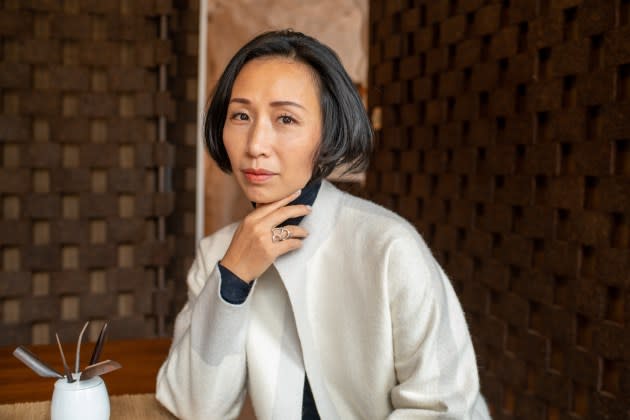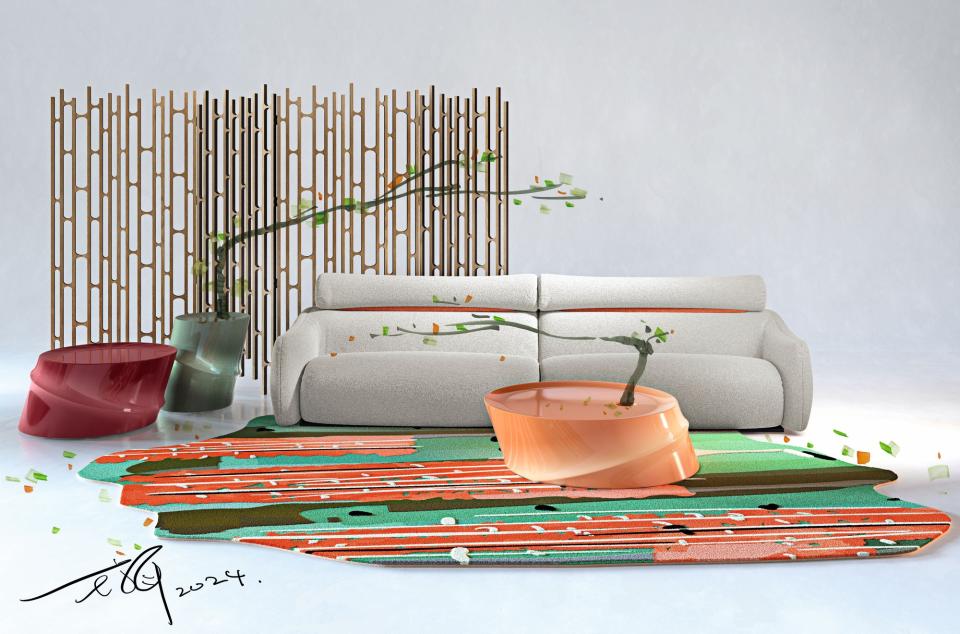Jiang Qiong Er Steps Onto the Milan Design Scene After Shang Xia

MILAN — The last time Jiang Qiong Er exhibited at Milan Design Week was nearly 20 years ago when she showcased her master’s graduation work from decorative arts school ENSAD (École nationale supérieure des Arts Décoratifs) in Paris. Fast forward to 2024 and a roster of awards later, and the decorated Chinese artist, designer and entrepreneur is back presenting her own collection of furniture with upscale French furniture house Roche Bobois. The “Bamboo Mood” collection includes a bamboo-effect screen, cocktail tables, a sofa and a console, together with rugs, cushions and ceramics, which will be open to the public April 15.
In addition to her work as an artist, Qiong Er is perhaps more widely known in the fashion world for creating luxury house Shang Xia, which she cofounded in 2009 with Hermès. Since Exor took a majority stake in the company and she stepped down as its creative director and CEO, she remained on the board and took on a new role as an adviser to Exor on its portfolio of brands, which include Christian Louboutin and Ferrari.
More from WWD
Colville's Upcycled Diadora Sneaker Capsule to Debut at Milan's Salone del Mobile
La Redoute to Show AMPM Home for First Time on International Stage
The artist, who lives between Paris and Shanghai, said now is the time to focus on personal artistic endeavors and collaborations with international luxury brands. Her career now centers on promoting fine Chinese craft, infusing traditional crafts with contemporary design, and interweaving Eastern and Western concepts to create a 21st-century way of life. Elsewhere, her works are exhibited in the permanent collections of some of the most famous museums in the world, such as the British Museum, the Victoria & Albert Museum in London, the Musée Guimet and the Musée des Arts Décoratifs in Paris, and more.
Qiong Er chats with WWD about her latest furniture collaboration, the Chinese design market and vision.
WWD: How did the collaboration between you and Roche Bobois come about?
Jiang Qiong Er: I have been familiar with Roche Bobois for 20 years now. This year marking the 20th anniversary of Roche Bobois in China. I have always admired the cultural diversity that Roche Bobois inspires. When Roche Bobois extended an invitation for me to create a collection with almost carte blanche, I immediately said “yes,” believing that this collaboration would lead to a beautiful human encounter and cultural conversation. And indeed, it has.
WWD: What sort of influences mark this collaboration?
J.Q.E.: An efficient conversation between traditional crafts and contemporary new material, a beautiful encounter between Chinese and French Art de Vivre, an elegant dialogue between traditional inspiration and modern expressions, a peaceful paradox between two different cultures.…Without using any Chinese elements, we feel the oriental spirit.
WWD: What is your artistic material of choice, and what are the artisanal aspects of this collaboration?
J.Q.E.: I love all the different artistic materials and crafts, as they always inspire me: silk, ceramic, lacquer, cashmere, wood-ship and, of course, bamboo. Bamboo has always fascinated me. Elegant, hardy, fluid and peaceful…it meets challenges with insolence and play. Bamboo bends but does not break. This collaboration, named Bamboo Mood, is an invitation to travel, an inexhaustible source of poetry and dreams.
WWD: What chapter of design is China experiencing right now?
J.Q.E.: Design in China is now blooming. Lots of designers have arrived on the stage, including designers of graphics, furniture, interiors, architects, light, animation, etc. It is a very diversified style and expression, so I call it a “blooming garden.” When we discuss design, it’s inevitably linked to manufacturing. After serving as the world’s factory for 20 years, China has made significant strides in adopting Western standards while maintaining reasonable costs.
WWD: You were a trailblazer in the retail space, envisaging the Chinese environments of the future; how was that a challenge?
J.Q.E.: Being a trailblazer is a passionate journey. It was a true avant-garde adventure when I founded Shang Xia with Hermès in 2009. The vision was clear: to create a Chinese maison with contemporary excellence. Our mission is to revive traditional Chinese crafts in the future through modern design with a unique expressive style. Being a pioneer is always full of challenges; without reference, we have to invent everything: create a high-end craft ecosystem, define brand core values, establish collection styles, design retail spaces, curate experiences, develop online interfaces, immerse in cultural experiences and more.
WWD: How do you determine the way forward?
J.Q.E.: I transform these challenges into creative energy by focusing on two core elements: Time and emotion, [and] experience and culture. I constantly ask myself, “How do I create timeless design? How can objects dance with time? How can a design evoke emotion? How can an experience be unforgettable? How do we engage with our past? How do we blend tradition with modernity? How does it reflect contemporary Chinese life?”
I am very happy to see more and more young Chinese people joining this journey. Designers, craftsmen and even clients are embracing it.
WWD: How should Italian design brands market themselves in China. Are brands focused on expansion there a household name yet, and if not why?
J.Q.E.: There are indeed a few Italian design brands that are famous in China after around 15 to 20 years of presence.
WWD: What sort of storytelling is imperative for foreign brands to effectively expand in China?
J.Q.E.: To expand in China today is not only about narrating one’s own story (it is important, but not all)….It’s more about a conversation, a cultural conversation. I believe that it is even more powerful when we create a dialogue. It is a story of dialogue where two cultures encounter. Today’s China is very different from 20, 30 years ago….When I was 20, the West was very new to us, so we were eager to learn and discover. With Chinese economic development, the young generation has more and more self-culture confidence, and we keep discovering, but we are eager for a dialogue, a cultural exchange. When a brand shares its brand story in this way, there is always a culture echo, which is powerful.

Best of WWD

